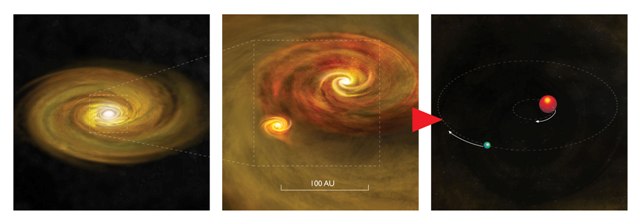Jan 2 2014
Using the new capabilities of the upgraded Karl G. Jansky Very Large Array (VLA), scientists have discovered previously-unseen binary companions to a pair of very young protostars. The discovery gives strong support for one of the competing explanations for how double-star systems form.
 Binary star formation through disk fragmentation starts (left) with a young star surrounded by a rotating disk of gas and dust. The disk fragments under its own gravity, with a second star forming within the disk (center), surrounded by its own disk. At right, the two stars form an orbiting pair. 100 Astronomical Units (AU) is roughly the diameter of our Solar System. CREDIT: Bill Saxton, NRAO/AUI/NSF
Binary star formation through disk fragmentation starts (left) with a young star surrounded by a rotating disk of gas and dust. The disk fragments under its own gravity, with a second star forming within the disk (center), surrounded by its own disk. At right, the two stars form an orbiting pair. 100 Astronomical Units (AU) is roughly the diameter of our Solar System. CREDIT: Bill Saxton, NRAO/AUI/NSF
Astronomers know that about half of all Sun-like stars are members of double or multiple-star systems, but have debated over how such systems are formed.
"The only way to resolve the debate is to observe very young stellar systems and catch them in the act of formation," said John Tobin, of the National Radio Astronomy Observatory (NRAO). "That's what we've done with the stars we observed, and we got valuable new clues from them," he added.
Their new clues support the idea that double-star systems form when a disk of gas and dust whirling around one young star fragments, forming another new star in orbit with the first. Young stars that still are gathering matter from their surroundings form such disks, along with jet-like outflows rapidly propelling material in narrow beams perpendicular to the disk.
When Tobin and an international team of astronomers studied gas-enshrouded young stars roughly 1,000 light-years from Earth, they found that two had previously-unseen companions in the plane where their disks would be expected, perpendicular to the direction of the outflows from the systems. One of the systems also clearly had a disk surrounding both young stars.
"This fits the theoretical model of companions forming from fragmentation in the disk," Tobin said. "This configuration would not be required by alternative explanations," he added.
The new observations add to a growing body of evidence supporting the disk-fragmentation idea. In 2006, a different VLA observing team found an orbiting pair of young stars, each of which was surrounded by a disk of material. The two disks, they found, were aligned with each other in the same plane. Last year, Tobin and his colleagues found a large circumstellar disk forming around a protostar in the initial phases of star formation. This showed that disks are present early in the star formation process, a necessity for binary pairs to form through disk fragmentation.
"Our new findings, combined with the earlier data, make disk fragmentation the strongest explanation for how close multiple star systems are formed," said Leslie Looney of NRAO and the University of Illinois.
"The increased sensitivity of the VLA, produced by a decade-long upgrade project completed in 2012, made the new discovery possible," Claire Chandler of NRAO said.
The new capability was particularly valuable at the VLA's highest frequency band, from 40-50 GHz, where dust in the disks surrounding young stars emits radio waves. The astronomers observed the young stars during 2012 with the VLA and with the Combined Array for Research in Millimeter-wave Astronomy (CARMA) in California.
Tobin, Chandler, and Looney were part of a research team of astronomers from the U.S., Mexico, and the Netherlands. The scientists published their findings in the Astrophysical Journal.
The National Radio Astronomy Observatory is a facility of the National Science Foundation, operated under cooperative agreement by Associated Universities, Inc.